BUDAPEST – KRAKOW: 2005
 Friday, April 10, 2015 at 05:20PM
Friday, April 10, 2015 at 05:20PM We were both interested in seeing Budapest and Krakow, so a hike connecting those two cities seemed just the thing. Had we taken even a cursory glance at an atlas we might have noticed that the hyphen joining Budapest to Krakow represents many miles, a mountain range, and even one entire country that we had not expected to visit along the way. But even with those miscalculations, the hike was a lot better than Morocco!
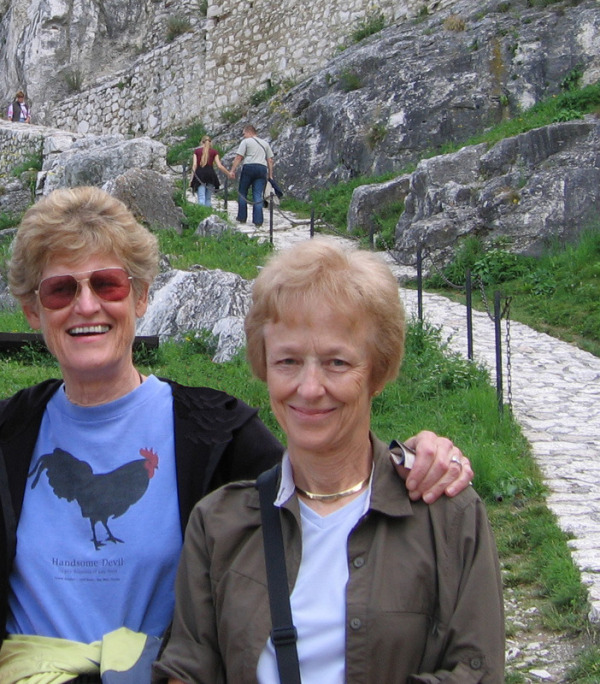 Ellie and Suzy
Ellie and Suzy
On arrival we made our way to our hotel on the Buda side of the Danube, napped, and then spent a leisurely afternoon walking around the pedestrian precinct on the Pest side of the river. We tried and failed to find any similarities whatsoever between Hungarian (Magyar) and English, but did succeed in finding an excellent restaurant for dinner.
We were scheduled to meet with our group later the next day, so in the morning we took in some of the many attractions of Budapest. The weather was perfect, and by good fortune Chain Bridge, one of the city's most important bridges across the Danube, had just been “pedestrianized” for the summer weekend. Small booths lined either side of the bridge, offering a vast variety of items and foods for sale. Although we had only just finished breakfast, one of us had to be physical dragged away from a woman selling sausage, onions and beer. At the Pest end of the bridge a five-person zither group produced music that haunts one of us to this day.
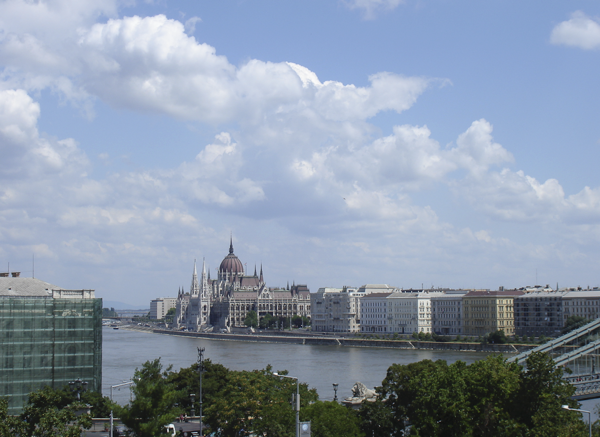 The River Danube in Budapest
The River Danube in Budapest
In stark contrast to the festive mood on Chain Bridge was the House of Terror (Terror Háza), which had been the Nazi Party HQ during the occupation (1944-45), and later housed the Hungarian Secret Police (AVO) during the Communist period. Emerging from that building we needed uplifting, and since one of us had been whining for several hours about being denied those sausages, onions and beer, we retraced our steps for the sake of peace and quiet. Then, however, we were faced with the problem of finding our way back to the hotel, which was by now quite a long way from where we were. By luck a young Hungarian couple noticed our confusion and asked if we needed any help. There followed this from them:
“We have good news. We speak some English. But we also have bad news. There is no metro from here to your hotel. But there is still some good news because the Number 86 bus stops nearby. Yet there is also bad news because you need to buy a ticket before you board the bus, and the ticket office is very far from here. So what you should do is “black ride” the bus., i.e. ride it without paying.” They added that bus drivers take fare-dodging seriously but usually don’t ask to see a ticket. Politely left unspoken was that obviously elderly tourists like ourselves, without a word of Hungarian, would probably avoid jail time. And we did. Safely back in our hotel we met the rest of our group, and walked back over to Pest for an enormous dinner of kabobs, sausages, dumplings and potato balls.
From Budapest we were driven to Eger, a picturesque city in northeastern Hungary, with an impressive castle. We took a short “warm up” hike past vineyards and through forests of beech trees before stopping for a picnic lunch. Then it was back to Eger to see its sights, one of which is the underground “Labyrinth” where wine has been stored since the 13th century. It was very, very cold down there, making it a perfect place for storing what wine the citizens were allowed to keep for themselves; one-tenth of what they produced always had to go to the local bishop. Our next stop was Tokaj, famous for the wine which bears its name. We were taken for a wine tasting and a detailed description of the process by which it is produced, albeit given in German, which presented some challenge.
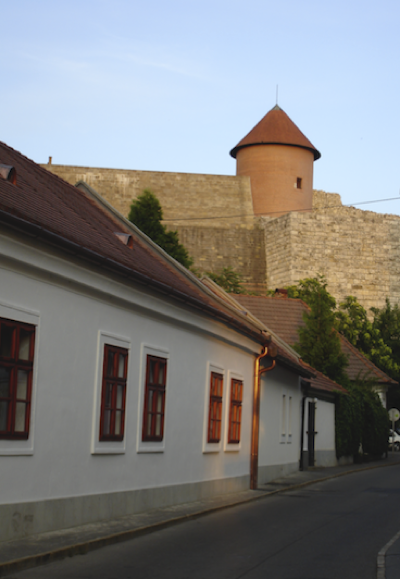 Eger, Hungary
Eger, Hungary
We were beginning to congratulate ourselves for having completely unwittingly signed up for a trip that featured more wining than hiking but the euphoria came to a crashing halt the next day when we crossed the border out of Hungary. Not only had we failed to notice that we would even be in Slovakia, but we found ourselves penniless once we got there. One of us had been in what was then Czechoslovakia many years earlier, and had carefully saved what she thought amounted to a king's ransom in leftover coins from that trip. These were now quite worthless, and of only mild interest to museums. The other of us, failing to take into account that Czechoslovakia had now split into two entirely separate countries, had exchanged dollars into Czech korunas before leaving the United States; these too were worthless in Slovakia. Far from living the high life, we were reduced to living off the charity of others until we could find an ATM.
After a night in the ancient city of Levoca, we were driven to Slovensky Raj (“Slovak Paradise”). We first hiked up to a viewpoint, but we could view nothing from it because of the bad weather. Then we hiked part way down into the gorge and made our way, in the pouring rain, above the River Hornad, aided by chains and “grilles” cantilevered out from the sheer rock wall over the water. The grilles were slippery because of the rain (which was now a torrential downpour), and walking on them was sufficiently unnerving that neither of us minded being assigned to the group that was not going to climb up the long, exposed iron ladders that were the quicker but scarier way out of the gorge. The cowardly and the brave, all soaked to the skin, eventually met up at the van.
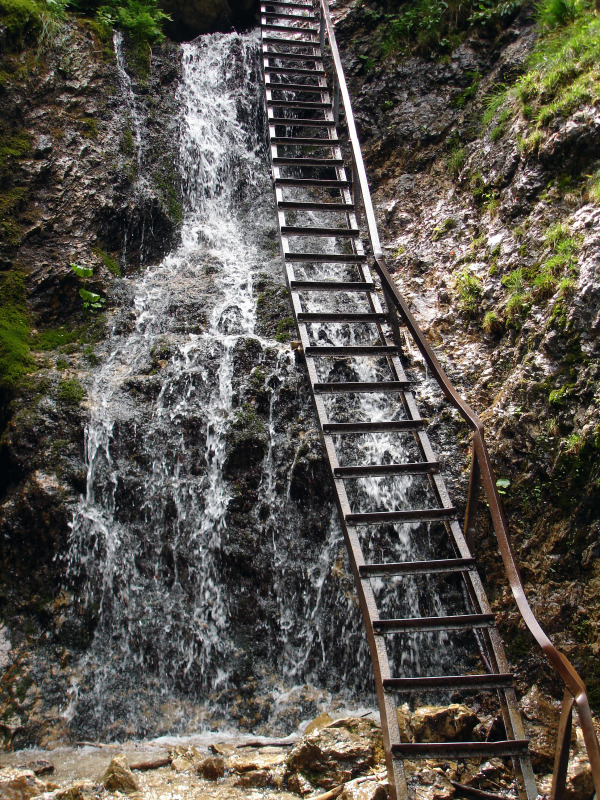 Ladder on Trail of Slovensky Raj
Ladder on Trail of Slovensky Raj
Outside of Levoca the next day loomed the picture perfect Spišský Hrad, or Spiš Castle. Dramatically situated on a hilltop, it is one of the largest castle complexes in Europe, and dates back to the beginning of the 12th Century. It was well worth visiting, and the views of the surrounding countryside from its towers were stunning.
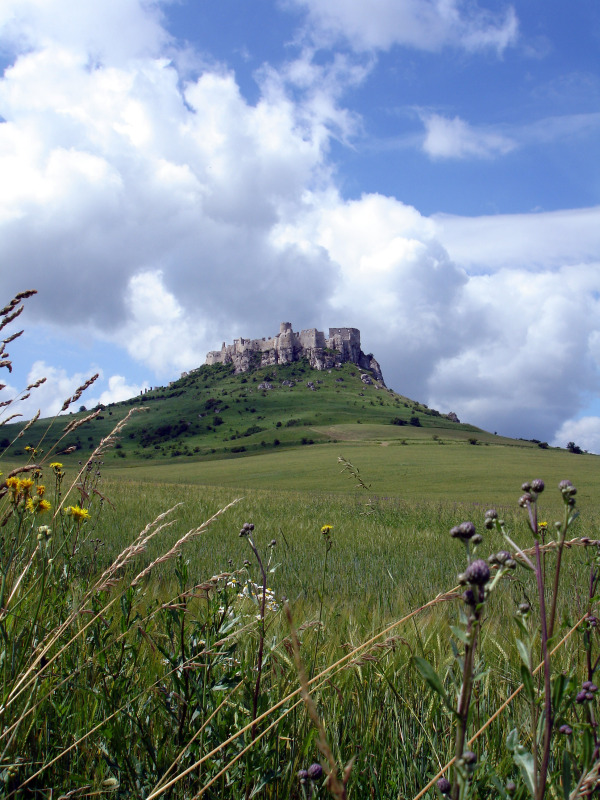 Spišský Hrad
Spišský Hrad
We then crossed out of Slovakia (for the first but not the last time) into Poland and made our way to Zakopane. The town lies in the Tatra Mountains, and is Poland's premier center for skiing and mountaineering. That night some of us tried the highly recommended local custom of mixing beer and strawberry syrup. It was not a great hit, but the dinner that followed was, featuring as it did the first of many pirogis.
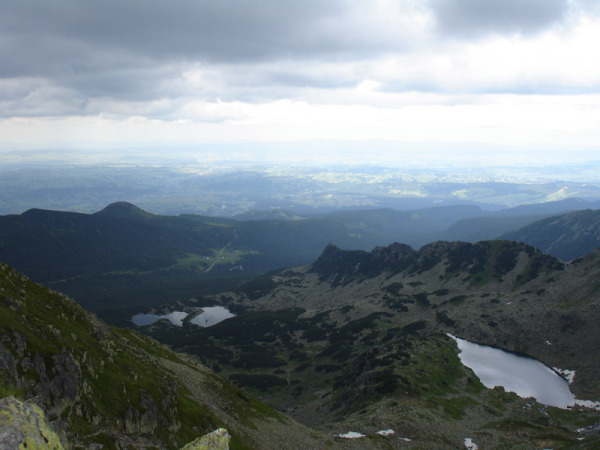 Tatra Mountains
Tatra Mountains
Careful readers will have noticed that up until this point there have been very few references to hiking, but that was about to change. The Tatra Mountains beckoned, and off we set on a respectable ascent. It was all good until we stopped for lunch, in what was the only restaurant on the mountain. It was large because it needed to be; there were lots of people out walking, and it seemed like the majority of them had chosen the same moment to stop for lunch. It was jammed, but that was only the beginning of the problem. One's food had to be ordered at Point A, a location on one side of the room, paid for at Point B, located on the other side of the room, and then collected at Point C, somewhere near Point A. Drinks required the same zigzag itinerary through the crush of people. And it wasn't the kind of crowd that made way for anyone. Commandeering a table at which to sit, once you had succeeded in actually getting any food, required an whole new set of skills which, fortunately for us, one of our guides possessed.
Compared to what came at the end of that day, the restaurant was a model of well-planned efficiency. We had the option of a quick cable car descent or a two-and-a-half hour walk back down to Zakopane, in what was then gathering darkness. Our guide strongly recommended the cable car. The scene at the cable car station was sheer madness. There appeared to be no discernible system for loading people into the cars, but because of some problem on the line, cars were coming up very slowly, if at all, and other people were proving much better at grabbing them when they did appear than we could ever hope to be. Meanwhile, more hikers were shoving their way into the small station by the minute, to at least twice the Maximum Capacity level. Claustrophobia set in and when our guide agreed that the situation was dangerous we forced our way towards the sliver of daylight we could just see above the sea of heads, took a deep breath, and set off downhill.
From Zakopane we were to double back into Slovakia, either on foot or by bus. Full disclosure requires us to admit that we chose the latter, mainly because the weather was too awful for there to be any good views of the mountains. (Those who hiked insisted that it cleared up soon after they started out, but we've heard that before and give it little credence.) But with that demerit already on our record there was some pressure on us the next day, and when our guide described the various options, we smugly chose the most challenging of them.
It began in thick fog with a gondola ride to the top of something we couldn't see at all. There was no visibility whatsoever, and when the gondola came to a stop (helpfully named “START”) we piled out, thinking we were at the top. We were quickly herded back into the gondola by an attendant for the continuation of the ascent. Whatever START may be, it certainly isn't a STOP; no one is allowed to get off there.
From the top of the gondola we set out immediately downhill, over a path of large, wet, slippery stones. The weather certainly detracted from what might have been a pleasant walk with good views. There were woods and a lovely waterfall, but beyond that it was a matter of watching one's feet and looking forward to a lunch stop, where some delicious garlic soup went a long way to redeeming the day.
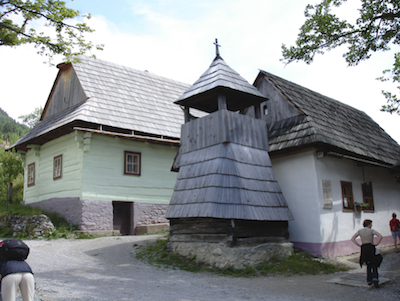 Vlkolínec
Vlkolínec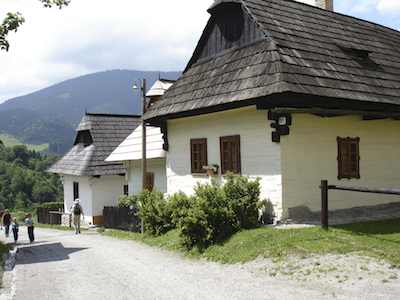 Vlkolínec
Vlkolínec
The following morning we walked to the medieval village of Vlkolínec. The picturesque village, the first written mention of which was made in 1376, is now a UNESCO World Heritage Site. The 45 log houses are typical of the architecture of the mountains of Central Slovakia. It was quiet and utterly charming. And a great contrast from the second architectural feature to which we were driven that day. Orava Castle is simply jaw-dropping. It is considered to be one of the most beautiful castles in Slovakia. The original Dracula movie (F. W. Murnau’s “Nosferatu”) was filmed there 1922. Parts of the castle date from 1267, but it stands on the site of an earlier fortification built after the Mongol invasion of Hungary in 1241. It has gone through the customary life cycle of castles: construction, destruction, fire, ownership squabbles, etc., but is now a national monument.
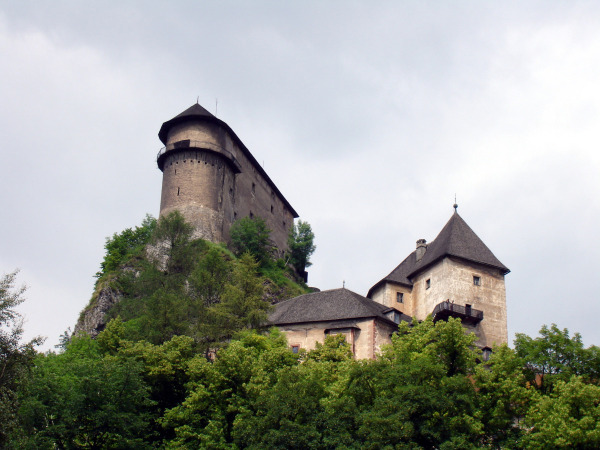 Orava Castle (site of original Dracula movie)
Orava Castle (site of original Dracula movie)
There followed another long bus ride to our last stop in Slovakia. The hotel there offered a new standard of awfulness; a sullen chambermaid insisted that she cleaned the bathrooms every month whether they needed it or not. But the kitchen was surprisingly good. Not only was there trout on the menu, but there was also trout in the kitchen! This was unusual; there was often the former, but seldom the latter, and hardly ever both.
The next day was our final hiking day, and it made up to some extent for all the hours we had spent in the bus. We self-identified as “climbers” or “walkers,” the main difference being one's comfort level with chains, ladders and precipices. For “climbers” the goal was the summit of Velký Rozsutec (5,281 feet).
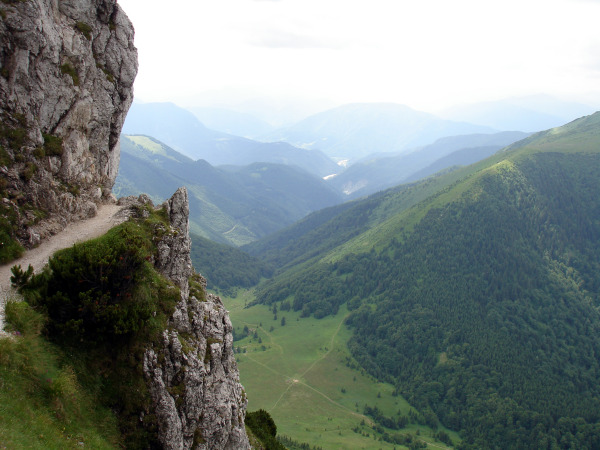 Ascent to Velký Rosutec
Ascent to Velký Rosutec
It was steep, and all the promised attractions (chains, etc.) were there, but the views and the sense of accomplishment at the top made it worthwhile. We dropped down a bit before stopping for lunch, to get out of the cold and wind, and then continued on a path that eventually deteriorated into thick mud. We had to grab on to young, flexible trees and slip and slide down the steepest parts until we were close enough to another tree to let go and grab on again. Each tree transfer required a leap of faith, and we were all fairly shattered by the time we met up with the “walkers,” who had thoughtfully commandeered a table in the garden of a small restaurant and were awaiting us with drink menus in hand.
And then it was on by bus to Krakow, one of the two reasons for our having come on the hike. It was reason enough. A guided walking tour of the city was arranged: the Jagiellonian University founded in the 14th Century, Wawel Royal Castle with its dragon legend, and many churches. There was a farewell dinner for the group that evening, but we had already planned to give Krakow the extra time it so richly deserves.
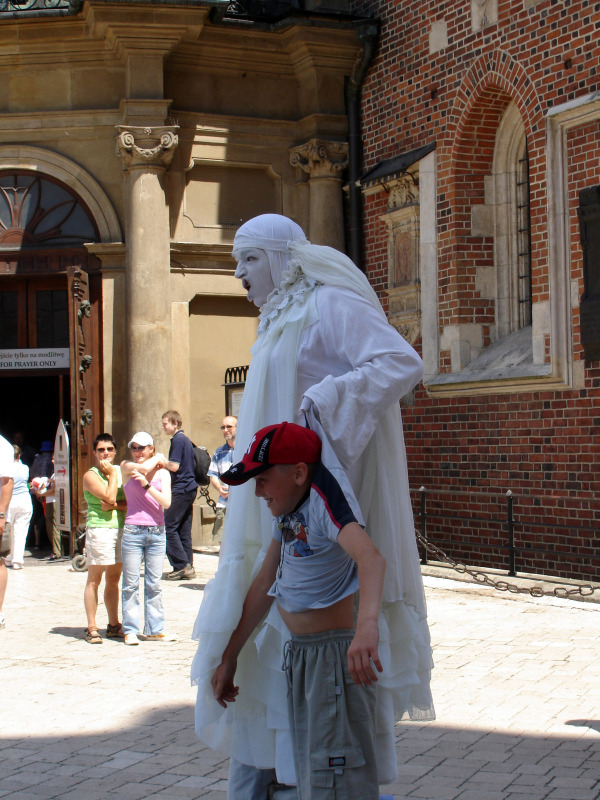 Street Performer in Krakow
Street Performer in Krakow
In retrospect: This was not so much a hike as it was a bus trip. We enjoyed the cities at each end, Budapest and Krakow, and in between them we experienced a part of the world that we probably would never have seen otherwise. It forced us to confront the question of whether, after ten years of hiking, we had reached the point where we liked hopping into a bus just as much as we liked lacing up our hiking boots? And the answer was No! Not that we were prepared to admit! And on the flight home we added a few more destinations to our list.
click here to see a gallery of the photos
